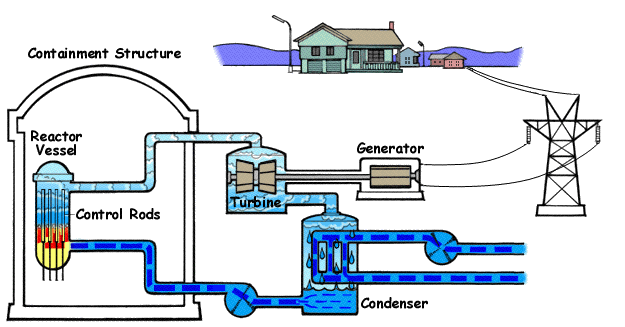Nuclear power plant
Nuclear power plants are a type of power plant that use the process of nuclear fission in order to generate electricity. They do this by using nuclear reactors in combination with the Rankine cycle, where the heat generated by the reactor converts water into steam, which spins a turbine and a generator. Nuclear power provides the world with around 11% of its total electricity, with the largest producers being the United States and France.[1]

Aside from the source of heat, nuclear power plants are very similar to coal-fired power plants. However, they require different safety measures since the use of nuclear fuel has vastly different properties from coal or other fossil fuels. They get their thermal power from splitting the nuclei of atoms in their reactor core, with uranium being the dominant choice of fuel in the world today. Thorium also has potential use in nuclear power production, however it is not currently in use. Below is the basic operation of a boiling water power plant, which shows the many components of a power plant, along with the generation of electricity.

Components and Operation
Nuclear Reactor
The reactor is a key component of a power plant, as it contains the fuel and its nuclear chain reaction, along with all of the nuclear waste products. The reactor is the heat source for the power plant, just like the boiler is for a coal plant. Uranium is the dominant nuclear fuel used in nuclear reactors, and its fission reactions are what produce the heat within a reactor. This heat is then transferred to the reactor's coolant, which provides heat to other parts of the nuclear power plant.
Besides their use in power generation, there are other types of nuclear reactors that are used for plutonium manufacturing, the propulsion of ships, aircraft and satellites, along with research and medical purposes.[4] The power plant encompasses not just the reactor, but also cooling towers, turbines, generators, and various safety systems. The reactor is what makes it differ from other external heat engines.
Steam Generation
The production of steam is common among all nuclear power plants, but the way this is done varies immensely.

The most common power plants in the world use pressurized water reactors, which use two loops of circling water to produce steam.[6] The first loop carries extremely hot liquid water to a heat exchanger, where water at a lower pressure is circulated. It then heats up and boils to steam, and can then be sent to the turbine section.
Boiling water reactors, the second most common reactor in power generation, heat the water in the core directly to steam, as seen in Figure 2.[6]
Turbine and Generator

Once steam has been produced, it travels at high pressures and speeds through one or more turbines. These get up to extremely high speeds, causing the steam to lose energy, therefore, condensing back to a cooler liquid water. The rotation of the turbines is used to spin an electric generator, which produces electricity that is sent out the the electrical grid.[8]
Cooling Towers
Perhaps the most iconic symbol of a nuclear power plant is the cooling towers, seen in Figure 4. They work to reject waste heat to the atmosphere by the transfer of heat from hot water (from the turbine section) to the cooler outside air.[4] Hot water cools in contact with the air and a small portion, around 2%, evaporates and raises up through the top. Moreover, these plants do not release any carbon dioxide—the primary greenhouse gas that contributes to climate change. Click here to see how a cooling tower works.
Many nuclear power plants simply put the waste heat into a river, lake or ocean instead of having cooling towers. Many other power plants like coal-fired power plants have cooling towers or these large bodies of water as well. This similarity exists because the process of turning heat into electricity is almost identical between nuclear power plants and coal-fired power plants.
Efficiency
The efficiency of a nuclear power plant is determined similarly to other heat engines—since technically the plant is a large heat engine. The amount of electric power produced for each unit of thermal power gives the plant its thermal efficiency, and due to the second law of thermodynamics there is an upper limit to how efficient these plants can be.
Typical nuclear power plants achieve efficiencies around 33-37%, comparable to fossil fueled power plants. Higher temperature and more modern designs like the Generation IV nuclear reactors could potentially reach above 45% efficiency.[6]
Further Reading
Please visit the following pages for much more information on nuclear science and its role in the energy industry.
- Uranium
- Nuclear reactor
- Nuclear power
- Nuclear fission
- Nuclear fuel cycle
- Nuclear waste
- Or explore a random page
References
- ↑ IEA (2014), "World energy balances", IEA World Energy Statistics and Balances (database). DOI: http://dx.doi.org.ezproxy.lib.ucalgary.ca/10.1787/data-00512-en (Accessed February 2015)
- ↑ Wikimedia Commons [Online], Available: https://upload.wikimedia.org/wikipedia/commons/5/58/Darlington_Nuclear_Generating_Station_panorama2.jpg
- ↑ NRC. (June 25 2015). Boiling Water Reactor [Online], Available: http://www.nrc.gov/reading-rm/basic-ref/students/animated-bwr.html
- ↑ 4.0 4.1 J.R. Lamarsh and A.J. Baratta, "Non-Nuclear Components of Nuclear Power Plants" in Introduction to Nuclear Engineering, 3rd ed., Upper Saddle River, NJ: Prentice Hall, 2001, ch.4, sec.3, pp. 129-133
- ↑ wikimedia Commons [Online], Available: https://upload.wikimedia.org/wikipedia/commons/7/79/Dampfturbine_Montage01.jpg
- ↑ 6.0 6.1 6.2 World Nuclear Association. (June 30 2015). Nuclear Power Reactors [Online], Available: http://www.world-nuclear.org/info/Nuclear-Fuel-Cycle/Power-Reactors/Nuclear-Power-Reactors/
- ↑ Michael Kappel on Flickr [Online], Available: https://www.flickr.com/photos/m-i-k-e/6541544889
- ↑ J.R. Lamarsh and A.J. Baratta, "Power Reactors and Nuclear Steam Supply Systems" in Introduction to Nuclear Engineering, 3rd ed., Upper Saddle River, NJ: Prentice Hall, 2001, ch.4, sec.5, pp. 136-185

